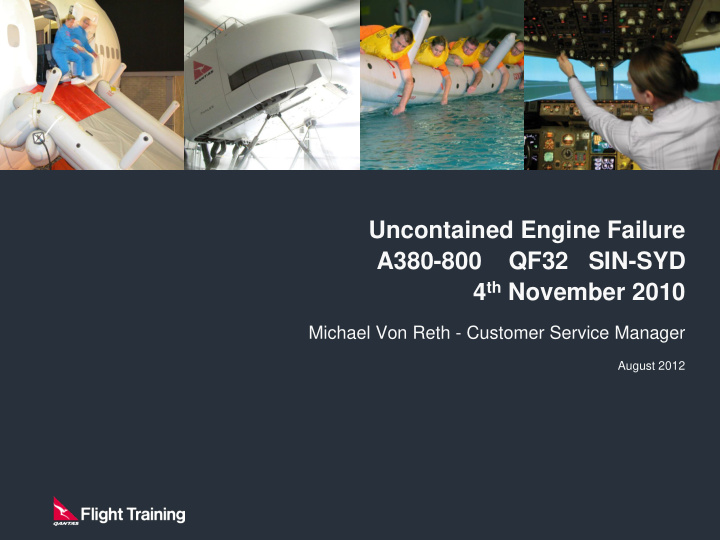



Uncontained Engine Failure A380-800 QF32 SIN-SYD 4 th November 2010 Michael Von Reth - Customer Service Manager August 2012
A380 Statistical Data Key figures Capacity Overall length 72.72 meters Passengers Wingspan 79.75 meters Typical seating (3-class) 525 Range 15.400 kilometers Maximum seating 853 Dimensions Freight Cabin length Capacity underfloor 38 LD3 Containers Main deck 49.90 meters pallet number max 13 Upper deck 44.93 meters Performance Fuselage width 7.14 meters Max take-off weight 560 metric tonnes Max Cabin width Max landing weight 386 metric tonnes Main deck 6.54 meters Max fuel capacity 320 metric tonnes Upper deck 5.80 meters Cabin Interior (Qantas) Engines Passenger seats 450 4 Roll Royce Trent 900x4 Crew Jump seats 24 Thrust range 311kN Galleys 20 Toilets 16+1 (flight deck)
Qantas Flight Attendant Video
QF32 Flight Details Qantas A380-800 VH-OQA Second leg of LHR-SIN-SYD flight 5 Flight Crew (Due to training duties) 24 Cabin Crew (2 crew supernumerary) 450 passengers
First signs Two loud explosive sounds about 5 min after Take Off Aircraft shuddering Engine cowling partially blown off Engine No.2 damaged, Structural damage on left wing Loss of Fuel and Hydraulic Fluid
Damage to the Aircraft
Damage to the Aircraft
Alze-jera News and Capt. David Evans In-flight P.A. - Video
First thoughts EP! What is the next step to follow? Need for change of priorities into Safety operating mode Managing an event with no procedure to follow
First actions Relaying information to the flight deck SO sent to assess the situation Passengers getting up CSM’s first PA to passengers Explaining the Cabin Crew role Asking for cooperation and compliance
Managing the Cabin Crew Walking around the aircraft assessing the situation in the cabin Discussion with Cabin Service Supervisor (CSS) • Primary Crew to remain at doors • Assist Crew in the cabin • Role of the CSS in an emergency situation Division of tasks between CSM and CSS
Managing the Passengers Passenger reaction Language issues Keeping passengers informed Importance of cabin presence
Preparing the Crew Briefing Small groups in the galleys Content Cabin Crew response to briefing 380 diagram
Safe Landing 150m from the end of the runway in SIN (4000m) ‘Alert PA’ from Captain Fuel leaking from the left wing, no fire fighters in sight Attempted to contact the Flight Crew but no response Eventually Captain rang with info PA to passengers re: PEDs
Commencing Disembarkation FFROs advised crew to disembark passengers via M2R Who opens the door?
Precautionary Disembarkation FFROs took control of Precautionary Disembarkation Passengers called up in groups of 20 Cabin Crew managing passenger movements Repeated PAs re: Cabin Baggage – High compliance Pax directed down stairs and on to bus to Terminal PA to Cabin Crew to check lavatories and cabin Crew transported to Terminal then assisted SIN Ground Staff
Factors contributing to crew dealing with the situation effectively Training instilled in crew Knowledge of their work environment Experience – Mix of ages and experience amongst the crew
Non Technical Skills used by the crew Situational Decision Making Awareness Communication Leadership and Teamwork Managerial Skills
Re-Introduction into Service Airbus A380-800 VH-OQA
Qantas 32 Technical and Cabin Crew Pilots and Cabin Crew of Qantas Flight 32 at the Annual Safety Excel Award Ceremony in Sydney
Any Questions?
Recommend
More recommend